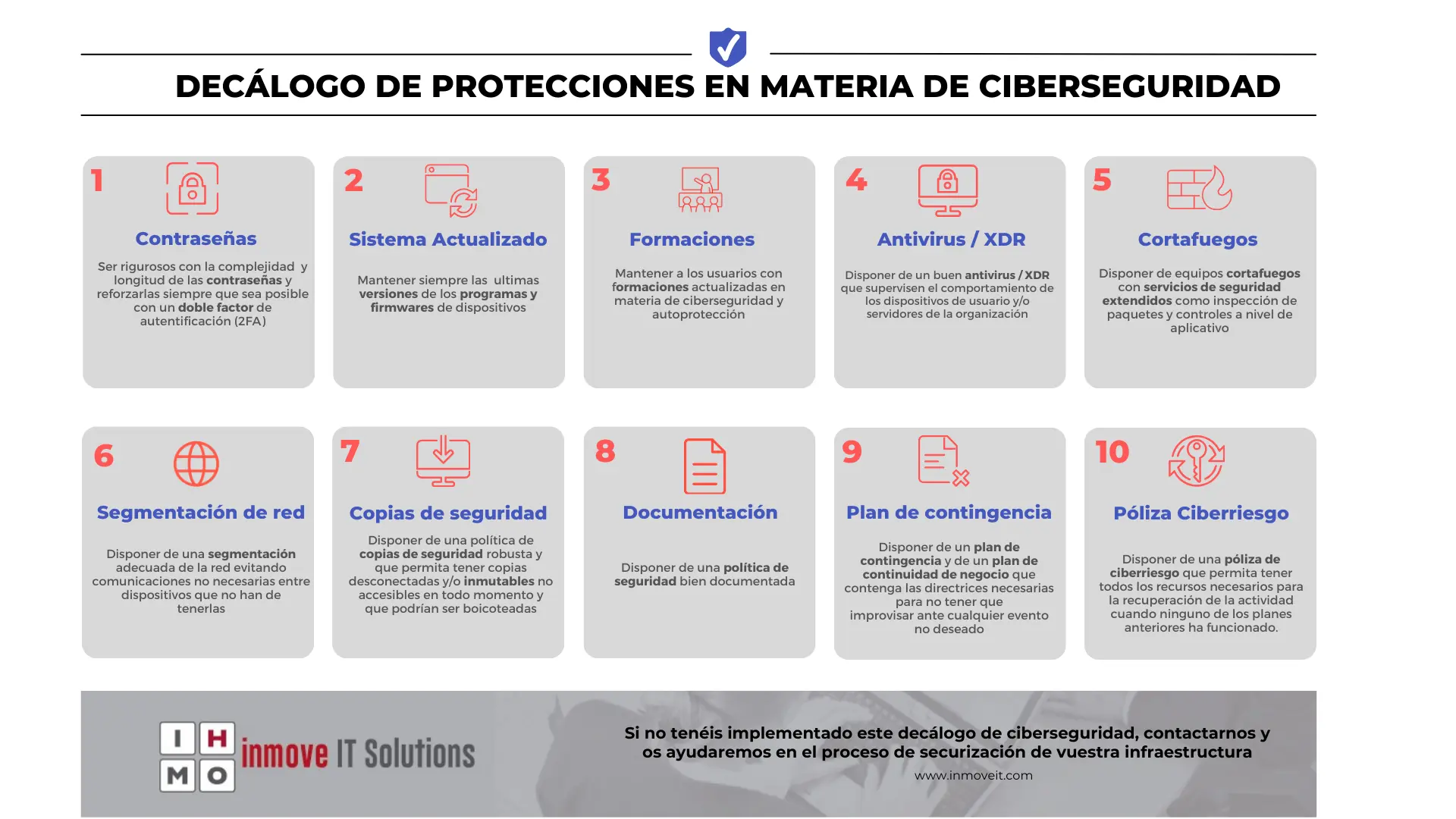In response to the growing wave of ransomware attacks we’ve seen recently, at Inmove IT Solutions we have implemented a series of security protocols to ensure the protection of our systems and those of our clients. This decalogue outlines the key cybersecurity measures we follow.

1. Secure passwords
We are strict with the complexity and length of passwords, reinforcing them whenever possible with two-factor authentication (2FA). This minimises the risk of unauthorised access.
Using strong passwords and two-step authentication adds extra layers of protection. A compromised login can expose sensitive data and critical systems. Credential management policies are key to preventing leaks. We use secure password management tools to enhance overall security.
2. Updated systems
We always keep our software and firmware up to date to prevent security vulnerabilities that could be exploited.
Regular updates fix bugs and strengthen defences against emerging threats. Attackers often exploit outdated software to breach systems. We automate updates wherever possible to prevent security gaps and monitor software versions to ensure stability and protection.
3. Ongoing training
Our team receives regular training in cybersecurity and self-protection to reduce the risk of incidents caused by human error.
Knowledge is the best defence against cyberattacks. A well-trained team can detect phishing attempts, identify unsafe practices, and respond to potential threats. Cybersecurity awareness is essential to prevent breaches caused by human mistakes. We run attack simulations and hands-on training to strengthen protection.
4. Antivirus and XDR
We use an advanced antivirus and XDR (Extended Detection and Response) technologies that monitor user device and server behaviour to detect threats in real time.
Advanced solutions allow for a proactive response to cyber threats. XDR extends protection by analysing multiple sources of information and correlating suspicious events. We detect and neutralise attacks before they cause significant damage. Continuous security analysis helps us improve the protection of our infrastructure.
5. Advanced firewalls
We deploy firewalls with extended security services, such as packet inspection and application-level controls, to protect our company’s infrastructure.
Firewalls serve as the first line of defence against unauthorised access and malicious traffic. We configure them to filter suspicious connections and prevent intrusions. Deep packet inspection allows us to detect exploitation attempts. We continuously monitor network activity to detect and respond to anomalies.
6. Network segmentation
We apply proper network segmentation to prevent unnecessary communication between devices and reduce the spread of potential threats.
Dividing the network into isolated segments helps contain security incidents. Malware propagation is significantly reduced by avoiding direct connections between unrelated systems. We enforce strict access rules between critical segments and user networks. This strategy enhances data protection and mitigates both internal and external attack risks.
7. Robust backups
We follow a strict backup policy, ensuring the existence of offline and immutable versions that cannot be accessed by ransomware attacks.
Backups are essential for data recovery after an incident. We use multi-location backup strategies to ensure redundancy. Storing offline copies securely prevents encryption in the event of an attack. We regularly test data restoration to guarantee availability when needed.
8. Security documentation
We maintain a documented security policy that enables us to respond quickly and effectively to any incident.
Clear, up-to-date documentation simplifies incident management. Defining procedures and responsibilities improves response times. We keep detailed records of access, configurations, and implemented measures. This documentation is vital for audits and the continuous improvement of our cybersecurity policies.
9. Contingency plan
We have a contingency plan and a business continuity plan that allow us to respond without improvisation to any unexpected event.
Being prepared for potential incidents ensures the stability of our operations. We define action protocols to minimise the impact of failures and attacks. Our plans are tested regularly to verify their effectiveness in real scenarios. Planning and preparation are essential to maintaining operability during any crisis.
10. Cyber risk insurance
We have a cyber risk insurance policy that provides the necessary resources to resume operations in the event that all previous measures fail.
Cyber insurance helps mitigate the financial and operational impact of a cyberattack. It ensures access to data recovery and incident management specialists. It complements our prevention strategies by providing an additional safety net. This enables us to respond quickly and minimise losses during critical situations.
Commitment to security
If you do not yet have a solid cybersecurity plan in place, at Inmove IT Solutions we will support you throughout the process of securing your infrastructure. Contact us for more information.

